Physical Address
304 North Cardinal St.
Dorchester Center, MA 02124
CNS viral infection associated with clinical or laboratory evidence of neurologic dysfunction based on viral tropism
Viruses: number one cause of encephalitis and meningitis
Most cases: acute, self-limited
Arboviruses: most common cause worldwide
U.S. incidence: 3.5 to 7.4 cases per 100,000 people per year
Specific host cell surface receptors facilitate entry
Routes: hematogenous (most common), retrograde neuronal migration (rabies/herpes)
Transient viremia seeds muscles/reticuloendothelial system
Secondary seeding of CNS, other organs
Infants, elderly most affected
Viral cultures: 33% to 75% are inconclusive
Meningitis: leptomeningeal infection—nuchal rigidity, headache, fever, photophobia
Aseptic: culture negative; unknown etiology
Encephalitis: direct viral infection of parenchyma—neurologic deficits; altered consciousness, seizures
Meningoencephalitis: parenchymal, leptomeningeal infection
Encephalopathy: reversible or irreversible damage without inflammation
Myelitis: spinal cord (poliovirus)
Radiculitis: dorsal nerve roots
Neuritis: peripheral nerves
Testing
Most cases diagnosed by PCR, ELISA serologies of CSF and serum
Viral cultures
CSF: moderate monocytic pleocytosis, mild/moderate protein increase, normal glucose
Most infections: self-limited; mild
High mortality: herpesviruses, some arboviruses
Neurologic sequelae common
Variable: based on pathogen
Antivirals: effective for certain pathogens
Cerebral edema, vascular congestion, foci of hemorrhage
Nonspecific findings
Lymphocytic meningitis
Perivascular lymphocytic cuffing
Microglial nodules of brain parenchyma in encephalitis
Destruction of neurons by activated microglia (“neuronophagia”)
Oligodendroglial destruction can lead to demyelination
Ependymitis
Gliosis
Viral cytopathic effects (covered in separate chapters)
Intranuclear inclusions (Cowdry type A: Herpes simplex, oligodendrocytic—JC virus)
Cytoplasmic inclusions (Negri bodies; rabies)
Pathogen-specific immunohistochemistry (IHC)
Immunohistochemical markers for lymphocytes, macrophages
Other infectious encephalitides
Cerebral infarct
Seizure disorders
Carcinomatosis/paraneoplastic encephalitis
Neurosarcoidosis
Thrombotic thrombocytopenic purpura (TTP)
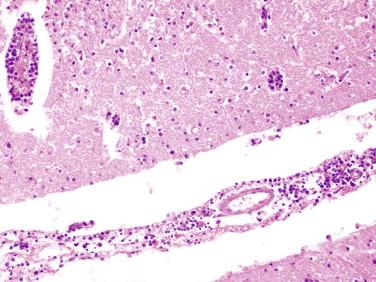
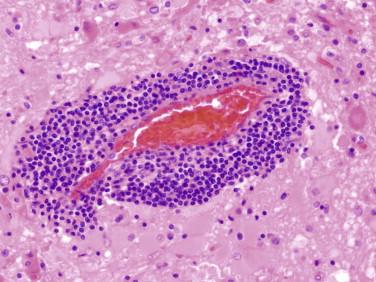
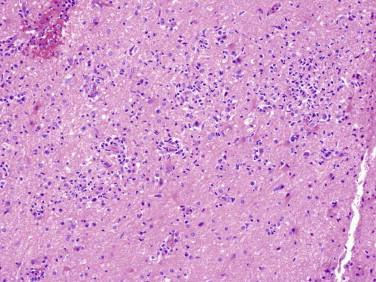

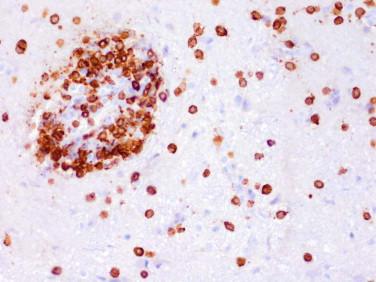
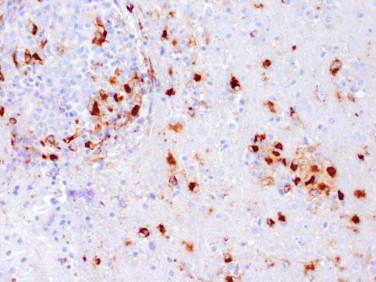
Acute necrotizing encephalitis caused by herpes simplex, an enveloped, double-stranded DNA virus
Most common sporadic encephalitis in the United States: two cases per million people per year
Neurotropic: likely spreads to leptomeninges via olfactory nerves
Primary infection: teens/young adults via direct contact with lesions/secretions
Herpes simplex virus (HSV-1): primarily oral lesions; 90% seroprevalence by age 50
Latency: trigeminal ganglion; occasionally cervical ganglia
Reactivation: occurs via anterograde axonal transport
HSV-2: primarily genital lesions; U.S. seroprevalence: 16% to 40%
Primary cause of encephalitis in neonates
Primary infection: up to 40%; reactivation: 8%
Latency: sacral dorsal root ganglia
Encephalitis: acute, rapid onset with fever, altered mental status, delirium/psychiatric manifestations, seizures, neurologic deficits, smell/taste alterations, coma
HSV-1: primary cause
Less common presentations:
HSV-1 and -2: subacute onset; insidious encephalopathic manifestations; rarely necrotizing myelopathy
HSV-1: brain stem encephalitis
HSV-2: sacral myeloradiculitis; Mollaret's meningitis—recurrent, benign aseptic meningitis
CSF analysis
Pleocytosis (lymphocytic/monocytic), red blood cells (RBCs) elevated, glucose normal/decreased
PCR for HSV-1 and -2
Cultures usually negative
Untreated: >70% mortality; 25% to 50% mortality with treatment
Sequelae common in survivors, even with appropriate treatment
Seizures (most common)
Severe neurologic deficits
Developmental delay
Treatment: acyclovir
Pathognomonic: asymmetrical increased signal intensity of bilateral temporal lobes with focal extension to adjacent frontal lobes
Cerebral softening, congestion, and edema
Hemorrhagic necrosis of bilateral temporal lobes in asymmetrical distribution
Extension to posterior orbitofrontal, cingulate, insular cortex
Acute phase—may initially have neutrophils in subarachnoid space and brain
Lymphohistiocytic infiltrates in leptomeninges; perivascular spaces
Neuronophagia/microglial nodules
Classic cytopathic effect: eosinophilic Cowdry type A intranuclear inclusions (sparse)
Neurons and glia infected
Progression to geographic necrosis, focal hemorrhage, marked inflammation
Chronic phase (survivors)
Cavitary glial scar formation with atrophy, hemosiderin deposition
HSV-1 and -2 immunohistochemistry
Become a Clinical Tree membership for Full access and enjoy Unlimited articles
If you are a member. Log in here